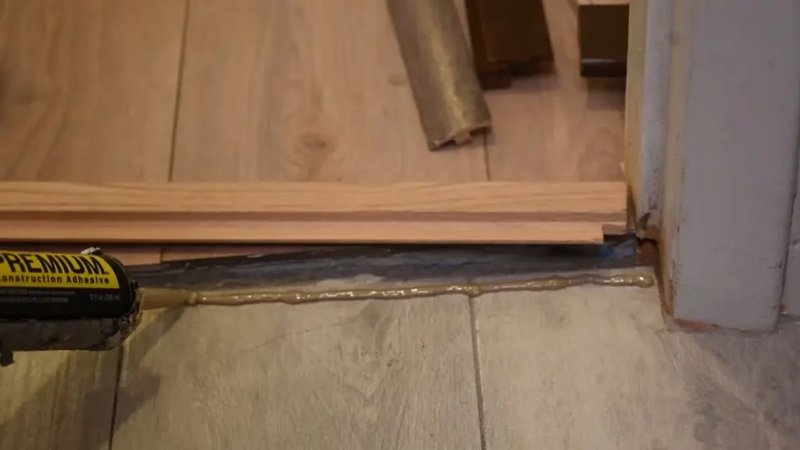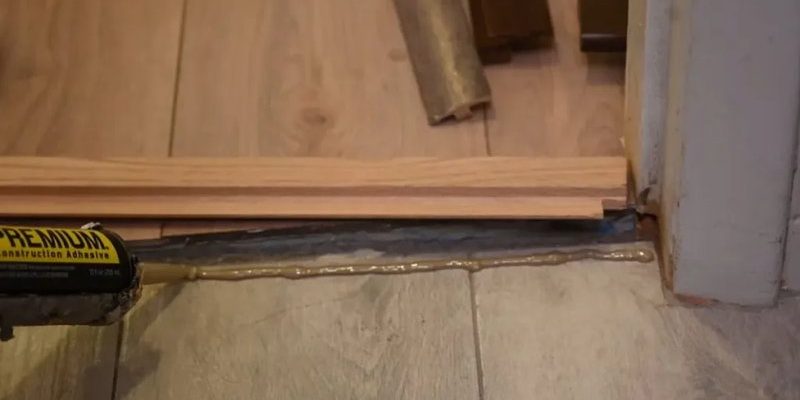
Choosing the best sealant for thresholds on uneven subfloors isn’t just about grabbing a random tube off the shelf. Some sealants are too rigid, others too oozy. Some brands just don’t stick where you need them, or they crack and peel after a season of temperature swings. You might see names like DAP, GE, or Loctite thrown around at the hardware store, but what matters most is how the sealant performs when the surface isn’t perfect—and how it holds up when people are stomping over it every day.
Let me explain what you need to know to get a *truly* sealed threshold, even when your subfloor does its best to mess things up. From the best sealant types and brands, to step-by-step installation tips, we’ll go through it all in plain English—no building degree required.
Why Threshold Sealant Matters For Uneven Subfloors
You might be wondering, “Isn’t any old caulk good enough?” Honestly, not even close—especially on an uneven subfloor. Thresholds are those strips at the bottom of the door, designed to bridge the gap between rooms or between inside and outside. Their main job: keep out drafts, bugs, moisture, and sometimes even light. But if the subfloor is lumpy or sloped, normal caulk or an ill-chosen sealant just can’t fill the gaps. You end up with cracks, air leaks, and, eventually, damaged flooring or subfloor.
When a subfloor isn’t totally flat, gaps can form under the threshold. Even tiny cracks let in cold air, humidity, or water during a heavy rain. Over time, that can mean mold, warped wood, or even a rotted subfloor. This isn’t just about comfort—it’s about protecting your whole floor system. Using the *best sealant for thresholds on uneven subfloors* means you get a product that can flex, hold up under foot traffic, and fill random-sized gaps without shrinking or pulling away.
Most generic sealants just aren’t up for the job. They don’t flex enough, or they get brittle after a year or two. You want something made for movement—especially in rooms where humidity and temperature shift (think: entryways, mudrooms, garages). The right sealant won’t just “stick”—it’ll adapt to minor shifts in the floor and threshold over time.
Types of Sealants That Work Best on Uneven Subfloors
Not all sealants are created equal, and this is where it pays to get a little picky. If you walk into a hardware store, you’ll typically see three main types:
- Silicone Sealants: Super flexible and waterproof. Great for areas that get a lot of moisture, but some formulas can’t be painted over, and not all silicones bond well with wood subfloors.
- Polyurethane Sealants: Tough, flexible, and paintable. These are a favorite for high-traffic areas because they can handle movement and seal larger gaps without cracking.
- Hybrid Sealants (Polyether or MS Polymer): These combine the flexibility of silicone with the toughness and paintability of polyurethane. They’re newer, a little pricier, but many pros swear by them for tricky surfaces.
Here’s where it gets interesting: on an uneven subfloor, I’d lean towards polyurethane or a good hybrid/MS polymer sealant. Silicone can work, but it has a tendency to “let go” from dusty or porous surfaces. Polyurethane bonds like a champ and stays slightly rubbery, so it stretches instead of cracking if the floor shifts a bit. For the best of both worlds, hybrid sealants (like Sikaflex or OSI QUAD MAX) can bridge unusual gaps and don’t mind a little surface quirkiness.
Let me toss out a real-world example: I once saw a mudroom threshold that was out by almost a quarter inch from left to right. The homeowner tried filling the edge with a basic paintable latex caulk—it worked for about a month, then shrank into the gaps, letting water sneak in after every rain. When they redid it with a polyurethane-based sealant, it held tight all winter—even with boots stomping right over it.
Top Sealant Brands for Thresholds on Uneven Subfloors
By now, you’re probably curious about which brands are worth your money. There are tons of options, but some names come up over and over in contractor circles—and for good reason.
- Sikaflex: Known for its polyurethane and hybrid sealants. Sikaflex 1a is a workhorse for thresholds. It bonds to just about anything and flexes like crazy, making it ideal for uneven subfloors.
- OSI QUAD MAX: This is a hybrid sealant favored for door and window installs. It handles big gaps, stays weatherproof, and can even be applied to damp surfaces—a plus for floor-level jobs.
- Loctite PL S40 Polyurethane: Affordable, reliable, and tough as nails. It’s perfect for wooden subfloors and won’t let go if the threshold shifts a hair.
- GE Silicone II: If you’re set on silicone, GE’s high-performance formulas play nice with tricky materials but make sure you don’t need to paint over it.
Here’s what sets these apart: they’re formulated specifically for movement, moisture, and temperature changes. You won’t see them peeling up or getting brittle after a few months. The big secret? Always check the label for “floor-rated,” “flexible,” or mention of adhesion to “uneven” or “irregular” surfaces—manufacturers know people are dealing with real-world messiness, not perfect showroom floors.
If you’re picking up a generic “window and door caulk,” you may not get the elasticity and gap-filling power you need. Spend a little extra for a tube that *specifically* mentions subfloor, threshold, or high movement properties. Your future self will thank you during the next thunderstorm.
How to Prep an Uneven Subfloor for Threshold Sealing
Honestly, even the best sealant can’t save you if you skip the prep. Think of prepping like cleaning the grill before you barbecue—if you leave last week’s crud, today’s meal is going to taste funky. For a threshold on an uneven surface, prepping means going the extra mile to get the best bond.
Start by cleaning the subfloor thoroughly. Vacuum up every crumb, dust bunny, or bit of old crumbling sealant. Then, scrub the area with a damp cloth and let it dry completely. Dirt and moisture are the enemy here—a sealant can’t stick to wood or concrete that’s oily, damp, or dusty.
If the subfloor is super wonky, you might need to fill extra-deep holes or valleys first. For gaps over 1/4 inch, pack them with backer rod (a squishy foam rope), then apply your sealant on top. This keeps you from wasting half a tube filling a canyon-sized crack, and helps your sealant stretch and flex the way it’s supposed to.
Here’s a quick rundown:
- Remove old caulk and debris (use a putty knife or scraper for stubborn spots).
- Vacuum and wipe down the area to remove dust.
- Dry the surface thoroughly—wet wood or concrete = bad adhesion.
- Use backer rod for large or deep gaps.
Prepping takes maybe twenty minutes, but skipping it can cost you hours in repairs later. Trust me, I’ve had to dig out soggy, failed thresholds more times than I’d like to admit.
Step-by-Step Guide: Sealing a Threshold On an Uneven Subfloor
Ready to start sealing? Here’s how to do it, even if your subfloor looks like a mini rollercoaster.
- Dry Fit the Threshold: Set your threshold on the subfloor to see where the biggest gaps and uneven spots are. Mark these with a pencil for easy reference.
- Apply Backer Rod: For deep gaps (over 1/4 inch), press a backer rod into the space beneath the threshold. This saves sealant and helps prevent cracks down the line.
- Load the Sealant: Cut the tip of your chosen sealant (polyurethane or hybrid recommended) at a slight angle. Pop it in your caulk gun.
- Apply a Bead: Squeeze a thick, continuous bead along the subfloor, focusing on the uneven or low spots. Don’t be shy—more is better than not enough, as extra can be wiped away.
- Place the Threshold: Set the threshold firmly in place. Press down to seat it into the sealant; if the subfloor is really uneven, you may need to stand on it or use weights.
- Tool the Sealant: Smooth out any excess with a damp finger or a caulking tool. The goal is a neat, slightly rounded bead all the way along the edges—no holes, no gaps.
- Clean Up: Wipe up any stray sealant immediately. Polyurethane and hybrids get stubborn once cured.
- Let it Cure: Check the product directions, but most sealants need 24–48 hours to cure fully. Keep off the area until it’s set—no shortcutting this step!
If you run into issues, like the sealant not sticking, double-check that the surface is clean and dry. For stubborn “bleed-through” or spots that just won’t seal, try roughing up the subfloor lightly with sandpaper to give the sealant a better grip.
Common Problems and Troubleshooting Threshold Sealant on Uneven Subfloors
Even if you follow every step, things can go sideways. Here’s some typical headaches, and how to fix them:
- Sealant Won’t Stick: Usually means the surface is wet or dirty. Clean again, or sand lightly to roughen slick spots.
- Threshold Rocks or Moves: If the subfloor is *really* hilly, you may need to shim the low side with thin wood or plastic. Then seal around those shims.
- Sealant Shrinks or Cracks: This happens with cheap latex caulk, or if you tried to fill a monster gap in one go. Use backer rod for anything over 1/4 inch deep and pick high-movement formulas only.
- Water Still Leaks In: Sometimes leaks happen at the ends, or from below the threshold if it’s not bedded firmly in the sealant. Double-check the corners and redo problem spots with a little extra sealant.
Don’t get discouraged. Sealing thresholds on uneven subfloors can be *weirdly* satisfying when you solve one of these problems—kind of like beating a tricky level in your favorite game.
Pro tip: Store your extra sealant (well-capped!) for touch-ups. Sometimes, after a week or two, you’ll spot tiny spots that need a little extra. No shame in a second pass!
Alternatives: Threshold Options for Seriously Uneven Subfloors
Now, sometimes the floor is so lumpy that no amount of sealant will do. If you’re dealing with truly wild unevenness—think old-school basements, sagging porches, or an ancient mudroom—there are alternatives to the classic stick-and-seal approach.
- Screw-Down or Adjustable Thresholds: Some thresholds come with adjustable screws or a flexible base that can be cranked up or down to match the floor. Once level, you can seal the edges.
- Install a Sill Pan or Sloped Shim: You can create a level platform for the threshold by adding a custom-cut shim (out of composite, vinyl, or treated wood) under the threshold, then seal as normal.
- Removable Vinyl or Foam Weatherstripping: In less permanent settings, stick-on weatherstripping can help bridge small gaps, though it won’t be as durable as high-end sealant.
Honestly, in really bad situations, it may make sense to consult a pro—sometimes fixing the subfloor itself is the best move in the long run. But nine times out of ten, the right sealant, used with care, will get that threshold snug and weatherproof.
Wrapping Up: Getting the Best Seal on an Uneven Subfloor Threshold
At the end of the day, sealing a threshold on an uneven subfloor is about working *with* the quirks of your floor—not against them. Choose a flexible, floor-rated sealant (polyurethane or hybrid brands like Sikaflex or OSI QUAD MAX), prep with backer rod if needed, and don’t skimp on cleaning or surface prep. Yes, it takes a little time and patience, but the results are worth it: fewer drafts, less water intrusion, and peace of mind every time you step through your door.
If you ever feel overwhelmed, remember you’re not alone—everybody hits a few hiccups when dealing with old, uneven subfloors. And hey, when you’re done and you feel that solid, sealed threshold underfoot, it’s honestly a little victory you’ll appreciate every time the weather turns rough.
